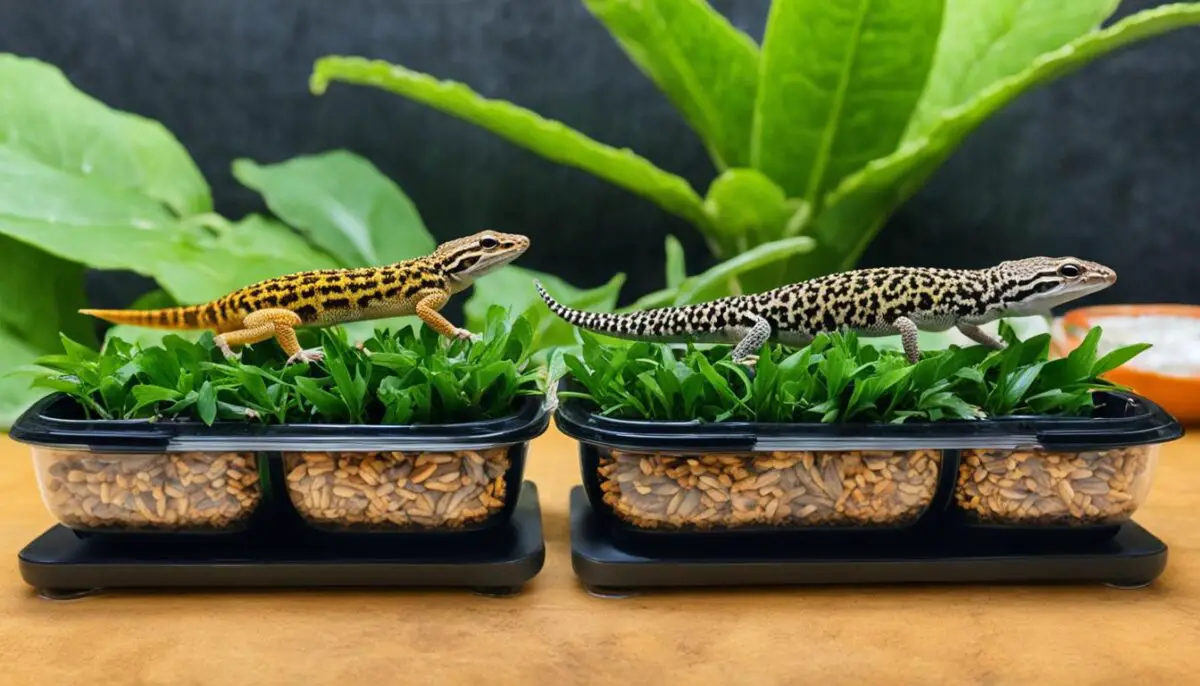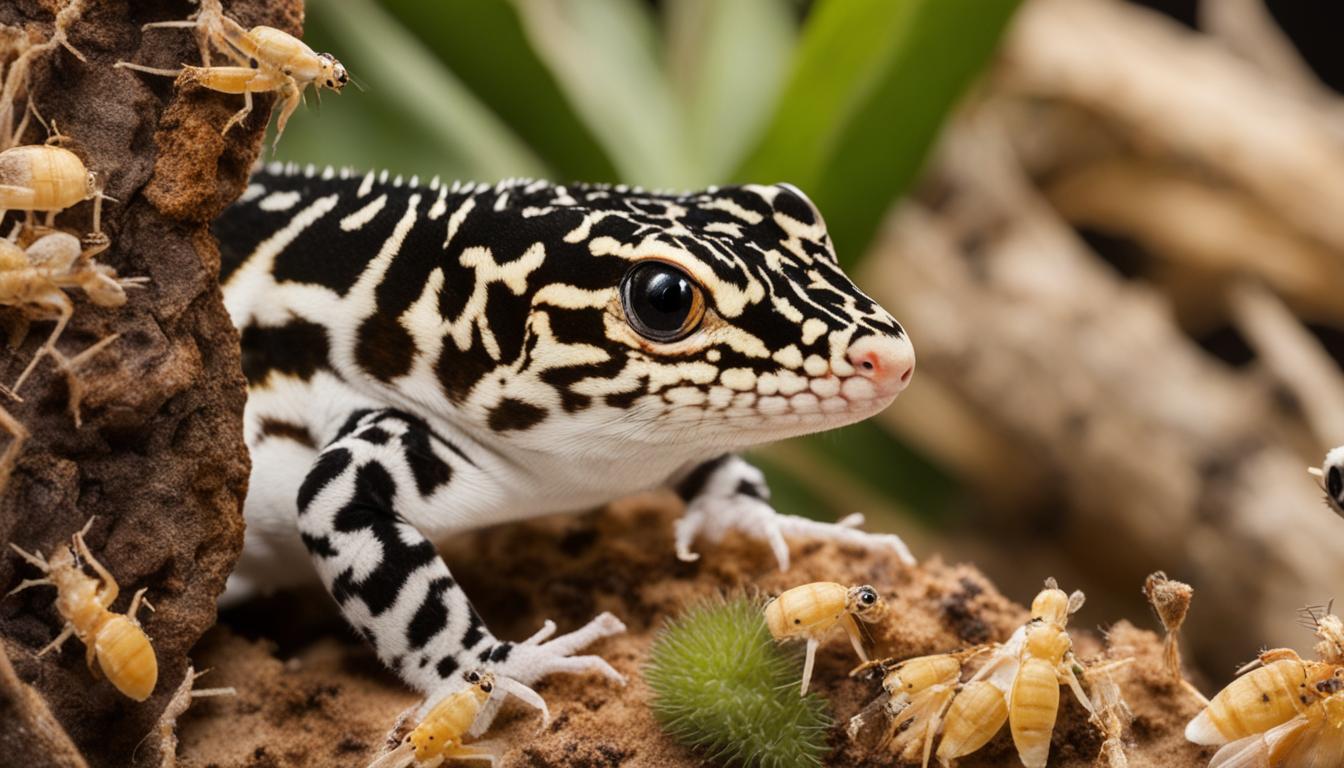Welcome to our comprehensive guide on leopard gecko feeding schedules. Feeding these insectivores the right food and in the right quantities is crucial for their health and well-being. In this article, we will provide you with a detailed meal plan and feeding frequency recommendations to ensure your leopard gecko thrives.
Key Takeaways:
- Leopard geckos are insectivores and should only be fed live insects.
- Offer 2 appropriately-sized bugs per 1 inch of your gecko’s length or how much they can eat in 15 minutes.
- Juveniles should be fed daily, young adults every other day or every 3 days, and adults every 5 days.
- Good feeder insects include crickets, mealworms, superworms, hornworms, Dubia roaches, discoid roaches, silkworms, and black soldier fly larvae.
- It’s important to offer a rotation of at least 3 different types of feeders for variety and nutrition.
Proper Feeding Schedule for Leopard Geckos at Different Stages of Life
Feeding your leopard gecko regularly and maintaining the appropriate feeding frequency is essential for their overall health and well-being. The feeding schedule may vary depending on the gecko’s age and size. Here’s a guide to help you understand the proper feeding schedule for leopard geckos at different stages of life:
1. Juvenile Leopard Geckos
During their early growth and development stage, juvenile leopard geckos require more frequent feeding. It is recommended to feed them on a daily basis. This regular feeding ensures that they receive the necessary nutrients to support their rapid growth.
2. Young Adult Leopard Geckos
Once your leopard gecko reaches young adulthood, you can adjust their feeding schedule. Young adults can be fed every other day or every 3 days, depending on their appetite and overall health. This feeding frequency helps maintain their weight and provides them with the necessary sustenance.
3. Adult Leopard Geckos
Adult leopard geckos, especially those with a tail thicker than their neck, require less frequent feeding. You can feed adult geckos every 5 days. However, it’s important to closely monitor their weight and adjust the feeding schedule accordingly. Regular feeding ensures that they receive the essential nutrients for their optimal health.
Remember, it’s crucial to provide a well-balanced diet for your leopard gecko, consisting of a variety of live insects to ensure they receive all the necessary nutrients. Regular feeding and proper nutrition contribute to the overall health and longevity of your leopard gecko.
Next, let’s take a look at the recommended feeder insects and treat options for leopard geckos.
Feeder Insects for Leopard Geckos
| Feeder Insect | Description |
|---|---|
| Crickets | Rich in protein and a staple food for leopard geckos |
| Mealworms | High in fat, suitable for occasional feeding |
| Superworms | Larger than mealworms, provide variety in diet |
| Hornworms | High in water content, great for hydration |
| Dubia Roaches | Excellent source of protein and low in fat |
| Discoid Roaches | Similar to Dubia roaches, but smaller in size |
| Silkworms | High in calcium and suitable for regular feeding |
| Black Soldier Fly Larvae | High in calcium and easily digestible |
Offering a variety of feeder insects ensures a nutritionally diverse diet for your leopard gecko.

Now that we’ve covered the proper feeding schedule and feeder insects, let’s explore the supplements necessary to support your leopard gecko’s nutritional needs.
Feeder Insects and Treat Options for Leopard Geckos
When it comes to feeding your leopard gecko, offering a variety of feeder insects is both enriching and essential for their nutrition. Here are some good options:
- Crickets
- Mealworms
- Superworms
- Hornworms
- Dubia roaches
- Discoid roaches
- Silkworms
- Black soldier fly larvae
By providing a rotation of these feeder insects, you ensure that your leopard gecko receives a varied diet, supplying them with important nutrients. However, it’s important to note that some insects should be given sparingly as treats due to their high fat content. These include wax worms and butter worms.
Feeder insects provide enrichment and varied nutrition for leopard geckos.
To maintain the health of your gecko, it’s essential to avoid offering bugs caught in your backyard as they can make your gecko sick. Additionally, pinky mice should only be offered if your gecko needs to gain weight after tail dropping, as they are not a regular part of their diet.
Now that you have a better understanding of the feeder insects and treat options for your leopard gecko, you can ensure they have a balanced and nutritious diet.

Water and Housing for Leopard Geckos
Proper care for your leopard gecko goes beyond just their feeding schedule. Providing clean, fresh water is essential to ensure their hydration needs are met. Place a shallow dish in their enclosure, making sure the water is deep enough for them to drink comfortably. However, be cautious not to make it too deep, as leopard geckos can potentially drown in deep water.
When it comes to housing, creating a suitable environment is crucial for the well-being of your leopard gecko. A single leopard gecko can thrive in a 10-gallon aquarium or container, with a minimum height of 6 inches. To prevent escape, make sure to use an enclosure with a secure screen top.
In addition to the proper enclosure, providing the necessary hiding spots and cage furnishings is important for your gecko’s mental and physical health. Include a hide box or hut where they can retreat and feel secure. Select appropriate substrate and cage decorations that mimic their natural habitat to create a stimulating environment.
Maintaining the right temperature in the cage is vital for the health of your leopard gecko. During the day, the temperature should be maintained in the mid-80s Fahrenheit (around 30 degrees Celsius), while nighttime temperatures can drop as low as 70°F (21 degrees Celsius) to simulate their natural environment.
While not mandatory, UVB lighting can benefit your leopard gecko’s overall health. UVB lighting helps with the synthesis of vitamin D3, which aids in calcium absorption. Providing a UVB light can help prevent metabolic bone disease in your gecko.
Creating an appropriate housing setup and ensuring access to clean water will contribute to the overall well-being and happiness of your leopard gecko.
https://www.youtube.com/watch?v=ed5MhCfObig
Tips for Water and Housing:
- Place a shallow dish of clean, fresh water in the enclosure.
- Ensure the water is deep enough for drinking but not deep enough to pose a drowning risk.
- Use a 10-gallon enclosure with a minimum height of 6 inches for a single leopard gecko.
- Secure the enclosure with a screen top to prevent escape.
- Provide a hide box or hut for your gecko to feel secure.
- Select appropriate substrate and cage decorations to mimic their natural environment.
- Maintain temperatures in the mid-80s Fahrenheit (30 degrees Celsius) during the day and as low as 70°F (21 degrees Celsius) at night.
- Consider providing UVB lighting to aid in the synthesis of vitamin D3.
Conclusion
Proper feeding is crucial for the health and well-being of leopard geckos. To ensure their nutrition needs are met, it’s important to follow a leopard gecko feeding guide that includes a variety of live insects appropriate for their age and size. Feeding schedules may vary, with juveniles needing to be fed more frequently than adults. It’s essential to monitor their weight and adjust the feeding schedule accordingly to maintain their optimal health.
In addition to a balanced diet, supplements such as calcium powder and multivitamins should be provided to ensure the leopard geckos receive all the essential nutrients. Calcium powder helps to balance the calcium-phosphorus ratio, while multivitamins supplement any potential deficiencies. These supplements are particularly important for leopard geckos without access to a UVB light source, which aids in the production of vitamin D3.
Proper housing and access to clean water are also vital for leopard geckos’ well-being. They should be housed in appropriate-sized enclosures with suitable substrate, cage furnishings, and a hide box or hut for comfort. Clean, fresh water should always be available in a shallow dish. Maintaining the recommended temperature range and providing appropriate UVB lighting, though not essential, can contribute to the overall health of the leopard geckos.
By following a leopard gecko feeding guide, monitoring their weight, providing necessary supplements, and ensuring proper housing and access to clean water, you can keep your leopard geckos healthy and thriving. Remember, each gecko is unique, so it’s important to observe their behavior and make adjustments accordingly to meet their individual needs.
FAQ
How often should I feed my leopard gecko?
Juvenile leopard geckos should be fed daily, young adults every other day or every 3 days, and adults with a fatter tail than neck can be fed every 5 days.
What types of insects should I feed my leopard gecko?
Good feeder insects for leopard geckos include crickets, mealworms, superworms, hornworms, Dubia roaches, discoid roaches, silkworms, and black soldier fly larvae. Offering a variety of feeders is recommended.
How much should I feed my leopard gecko?
Offer 2 appropriately-sized bugs per 1 inch of your gecko’s length or however much they can eat in 15 minutes.
What supplements do leopard geckos need?
All insect feeders should be dusted with calcium powder. If using a UVB light, a supplement with vitamin D3 is not necessary. Otherwise, a supplement with vitamin D3 should be used. An occasional multivitamin is also recommended for optimal nutrition.
How should I provide water and housing for my leopard gecko?
Leopard geckos should have access to clean, fresh water in a shallow dish. They should be housed in a 10-gallon aquarium or container with a minimum height of 6 inches. Screen tops are essential to prevent escape.


